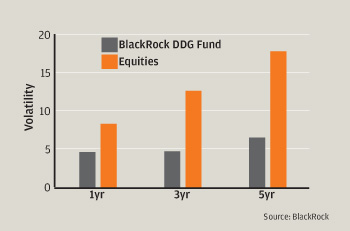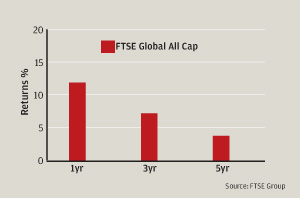How have DGFs performed over 1, 3 and 5 years?
Market sentiment has been with diversified growth funds ever since the financial crisis started. Their flexible approach to investing has allowed them to move into areas of opportunity and to avoid asset classes that were overvalued or that were about to crash. Now as equities recover their performance is not looking so spectacular.
Performance figures, though, only tell part of the story. DGFs are marketed as offering equity-like returns with much less volatility and going by the figures issued by Black Rock for its DGF, that is exactly what is happening (see chart one).
Baillie Gifford DGF(£2.8bn)
Net return: one year 10.8 per cent net; three years 8.5 per cent (Five-year n/a – launched Dec 2008).
The best-performing of the major DGFs over one and three years, Baillie Gifford’s idiosyncratic asset allocation has worked in its favour. Its largest allocation is10 per cent in emerging market debt, which yielded more than 20 per cent in 2012. A similar allocation to high yield bonds brought a plus 20 per cent return too. This is notable in that the fund only has, at present, a 15 per cent equity allocation.
Chris Murphy, product specialist at Baillie Gifford, says the better outlook for emerging market countries, their low level of debt and the expected appreciation in the currencies give a better risk-reward than developed world debt.
Another unusual allocation is to catastrophe bonds, which again did well in 2012.
Baring Dynamic Asset Allocation Fund (£6bn)
Net¹ return: 5.5 per cent, three years 5.7 per cent, five years 6.1 per cent.
Barings’ DAA is primed for equity gains in 2013 after increasing its equity holding from 30 per cent in January 2012 to 43 per cent today.
BlackRock DDG (£3.3bn)
Net figures: one year 7.3 per cent; three years 5 per cent; five years 4 per cent.
On the surface this is one of the more conventionally invested funds, with 33 per cent in developed market equities and 30 per cent government bonds, but it also uses hedge funds and derivatives to take opportunities or to make defensive moves.
Of late it has built up its equity allocations to benefit from the pick-up in prices and it has also built up a large tactical position in Japanese equities, a theme many investors believe will do well in 2013, partly as a result of much-needed deregulation from new prime minister Shinzo Abe.
It has also benefitted from a 28.5 per cent return on Italian bonds in 2012.
Newton Real Return Fund (7.1bn)
Gross return: one year 4.4 per cent; three years 5.2 per cent; five years 6.5 per cent.
This is another high conviction manager that has 25 per cent of the fund in 10 individual stocks. At the end of October these stocks were in pharmaceuticals, government bonds, oil and minerals.
Ruffer Total Return Fund (£2.5bn)
Net return: one year 2.4 per cent; three year 5.5 per cent, five year 9.5 per cent.
This is an idiosyncratic fund from a manager that does things differently. Notably it has built up a 19 per cent allocation to a small collection of Japanese equities, with the three largest stocks – Sumitomo Mitsui Financial, T&D Holdings, Mitsubishi UJF Financial – making up 6.5 per cent of the fund. If Japan benefits from deregulation and monetary policies from a new government, as some believe it will, then it could jump from being the worst-performing large DGF between 2012 to 2013 to the best. Its fund fact sheet adds: “A further part of our enthusiasm for Japanese equities, above and beyond the scope for policy change mentioned above, thus lies in the fact that Japan, as a cyclical equity market, tends to be positively correlated with rising bond yields.”
Schroders DGF (£4.6bn)
Net return: one year 7.6 per cent; three year 5.3 per cent; five year 3.2 per cent.
The fund has issued the following statement about its outlook for 2013. Johanna Kyrklund, head of multi-asset investments at Schroders, says: “In recent months we have started to reduce our strong quality bias by taking advantage of pockets of extreme value and we continue to seek ‘risk at a reasonable price’ in 2013. Our main concern is that government bonds look expensive. However, for the time being we do not expect them to be a source of instability.”
Standard Life Investments GARS (£13bn)
Net return: one year 7.7 per cent; three years 7 per cent; five years 6.9 per cent.
The most famous fund in the sector is noted for its tactical swoops in and out of niche assets as it anticipates reactions to economic events.
Its latest fund fact sheet states it hopes to do well from overweight holdings in bonds of financial services firms, which it expects to do well from a “variable and protracted recovery in global markets, with additional regulation of financial firms likely to reduce their credit risk, allowing us to exploit their high relative spread”.
It adds: “Growth prospects in emerging markets are another continuing investment theme around which we have a number of strategies in play.”
¹The Baring Baring Dynamic Asset Allocation Fund has experienced the following net returns: one year, 5.5 per cent; three years, 5.7 per cent; and five years, 6.1 per cent. The Pensions Week article, "How have DGFs performed over 1, 3 and 5 years?", published on January 22, incorrectly identified these as gross figures.
Most Viewed
- What does Labour have in store for the pensions industry?
- LGPS latest: GLIL backers invest £475m for UK infrastructure push
- Dashboard costs rose by 23% in 2023, figures show
- Border to Coast launches UK strategy in major private markets push
- How the pensions industry can better support people with mental health problems



